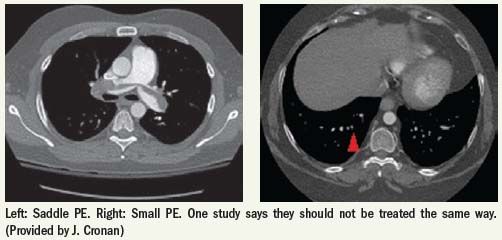Radiologists question whether to treat small pulmonary emboli
Nearly two years after a paper titled “Dots are not clots: the over-diagnosis and over-treatment of pulmonary embolism” was presented at the RSNA meeting, radiologists are still debating when to put patients on anticoagulation therapy.
Nearly two years after a paper titled “Dots are not clots: the over-diagnosis and over-treatment of pulmonary embolism” was presented at the RSNA meeting, radiologists are still debating when to put patients on anticoagulation therapy. Some say it depends on the size of the clots as well as their location. Others say if a patient has any evidence of pulmonary embolism, anticoagulation therapy should be provided.
Advances in CT allow detection of smaller and smaller pulmonary embolism (PE), but some clots occur naturally and don’t need to be disturbed, according to the paper, which was published recently in Emergency Radiology.

Incidental PE is detected in 1% to 5.7% of patients undergoing contrast-enhanced multislice CT of the chest for various clinical indications, which suggests physicians are diagnosing PE previously undetected by ventilation/perfusion scintigraphy or single-detector spiral CT, said the study authors.
The 64-slice scanner detects very small clots that physicians never saw before, said Dr. John Cronan, radiologist in chief at Rhode Island Hospital in Providence and one of the study’s authors.
“The amount of PE in the population, if you call those little dots PE, is skyrocketing,” he said. “Yet there's no indication more people are dying from PE, it’s just we’re seeing subclinical disease that existed before [and] had no clinical impact on the patient. Now we’re finding it.”
Physicians were perhaps better served not knowing small PE exists, because now they’re wont to treat it, he said.
Not all PE are abnormal, and small peripheral PE are a function of life, he said. Most radiologists report any filling defect, regardless of size, as clinically significant when detected in these vessels. Small dots in the pulmonary arteries are not clinically significant clots in the conventional setting, he said.
In their retrospective study, Cronan and colleagues included 1273 consecutive CT studies performed at Brown University, 101 (79%) of which were positive. Fifty patients had a lower extremity venous ultrasound performed within seven days of CT.
In 33 patients, an extensive clot load was detected in the central pulmonary arteries and termed classic PE. More than half (58%) had deep vein thrombosis and all of the patients received anticoagulation treatment.
In 17 patients, small clots (dots) were found in the peripheral pulmonary arteries (segmental, subsegmental, and distal fifth-order branches), with an average width of 2.5 mm. None had deep vein thrombosis and 88% received anticoagulation treatment.
Dots were not associated with detectable clot load in the lower extremities, which suggests small clots passing from the lower extremities
to the lungs is a physiologic process with the lung capillary beds trapping and dissolving the emboli, thereby protecting the systemic circulation, the authors said.
“We believe that dots may represent normal embolic activity originating from the lower extremity venous valves,” the authors said.
Since the paper was presented nearly two years ago, the protocol at Rhode Island Hospital has changed.
“Our doctors will not give anticoagulation to patients who have one or two dots,” Cronan said. “They get a venous ultrasound of the leg and if there’s no clot in the leg, the doctors don’t anticoagulate.”
Not everyone is sure the study proves patients with small emboli do not require anticoagulation therapy.
“The study is one of many that has indirectly addressed the issue, since a controlled study in a large cohort of untreated patients with dots has not been performed,” said Drs. Lawrence Goodman and Kaushik Shahir, experts in PE and radiologists at the Medical College of Wisconsin in Milwaukee. “The majority of 'dots patients' were anticoagulated, so the authors did not prove the benign nature of dots.”
Radiologists are still pondering where to draw the line.
“Do you treat one dot? Two?” Cronan said.
As always, more studies are needed to answer that question.
Expanded FDA Approval Allows Use of Pluvicto Prior to Chemotherapy in Patients with mCRPC
March 28th 2025Recent research demonstrated a 59 percent reduced risk of progression or death with the radioligand therapy Pluvicto in comparison to a change of androgen receptor pathway inhibitor (ARPI) for patients with metastatic castration-resistant prostate cancer (mCRPC).
The Reading Room Podcast: Current Perspectives on the Updated Appropriate Use Criteria for Brain PET
March 18th 2025In a new podcast, Satoshi Minoshima, M.D., Ph.D., and James Williams, Ph.D., share their insights on the recently updated appropriate use criteria for amyloid PET and tau PET in patients with mild cognitive impairment.
GE HealthCare to Launch PET MPI Agent Flyrcado at ACC Conference
March 28th 2025The positron emission tomography myocardial perfusion imaging (PET MPI) agent, which offers a significantly higher half-life than other cardiac PET agents, was recently granted pass-through payment status by CMS that will go into effect on April 1, 2025.
New Collaboration Offers Promise of Automating Prior Authorizations in Radiology with AI
March 26th 2025In addition to a variety of tools to promote radiology workflow efficiencies, the integration of the Gravity AI tools into the PowerServer RIS platform may reduce time-consuming prior authorizations to minutes for completion.